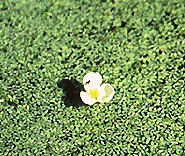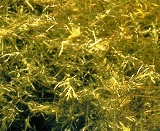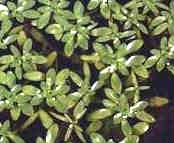Discover Florida Nature
It's time to explore the natural Florida


|
|
|
|
|
Submersed plants are large plants that grow primarily below the water's
surface. In Florida, Submersed plants occur in virtually all Florida
water bodies. In an individual water body, the availability of light,
water clarity, water depth, and sediment stability affect where
submersed plants will grow. Awl-leaf
(Sagittaria subulata)- Common in shallow waters near the coast
this plant may bloom throughout the winter in spring fed streams of
Florida. Awl-leaf grows to a height of 8-16 inches, and produces tiny
white flowers. It spreads by runners. This plant has basal leaves only.
Each long narrow leaf is entire and sometimes become slightly wider
toward the tip. They float but do not rise above the surface of the
water. The awl-leaf arrowhead flowers have 3 Regular Parts. The white
blooms first appear in mid summer and continue into mid fall. The
flowers are usually just above the surface of the water. Awl-leaf
(Sagittaria subulata)- Common in shallow waters near the coast
this plant may bloom throughout the winter in spring fed streams of
Florida. Awl-leaf grows to a height of 8-16 inches, and produces tiny
white flowers. It spreads by runners. This plant has basal leaves only.
Each long narrow leaf is entire and sometimes become slightly wider
toward the tip. They float but do not rise above the surface of the
water. The awl-leaf arrowhead flowers have 3 Regular Parts. The white
blooms first appear in mid summer and continue into mid fall. The
flowers are usually just above the surface of the water. Coontail
(Ceratophyllum demersum)- Coontail is a submersed with no roots, and so
is free-floating. It is frequently found growing in ponds, lakes,
streams, and sluggish waters from the peninsula to the central and
western peninsula of Florida. There are three species of
Ceratophyllum in Florida. Because its feathery leaves are arranged
in whorls on the stem, this plant resembles a
raccoon's tail. The fan-shaped leaves are best observed in the
water. They look feathery because each leaf is divided into many narrow
segments. Each leaf has several small teeth on the midribs. These tiny
teeth give the plant a rough feel when pulled through the hand.
Coontail's flowers are very small and rarely seen. The seeds and leaves
of the coontail are occasionally eaten by waterfowl. Coontail
(Ceratophyllum demersum)- Coontail is a submersed with no roots, and so
is free-floating. It is frequently found growing in ponds, lakes,
streams, and sluggish waters from the peninsula to the central and
western peninsula of Florida. There are three species of
Ceratophyllum in Florida. Because its feathery leaves are arranged
in whorls on the stem, this plant resembles a
raccoon's tail. The fan-shaped leaves are best observed in the
water. They look feathery because each leaf is divided into many narrow
segments. Each leaf has several small teeth on the midribs. These tiny
teeth give the plant a rough feel when pulled through the hand.
Coontail's flowers are very small and rarely seen. The seeds and leaves
of the coontail are occasionally eaten by waterfowl. Eel
Grass (Vallisneria americana)- Eel grass, sometimes called tape
grass, is a submersed plant that spreads by runners and sometimes forms
tall underwater meadows and is commonly found growing in lakes and
streams nearly throughout Florida. Vallisneria americana blooms
all year and occurs almost always (estimated probability 99%) under
natural conditions in wetlands. Eel grass leaves arise in clusters from
their roots. They are about one inch wide and can be several feet long.
The leaves have rounded tips, and definite raised veins. Single white
female flowers grow to the water surface on very long stalks. Eel grass
fruit is a banana-like capsule having many tiny seeds. Eel
Grass (Vallisneria americana)- Eel grass, sometimes called tape
grass, is a submersed plant that spreads by runners and sometimes forms
tall underwater meadows and is commonly found growing in lakes and
streams nearly throughout Florida. Vallisneria americana blooms
all year and occurs almost always (estimated probability 99%) under
natural conditions in wetlands. Eel grass leaves arise in clusters from
their roots. They are about one inch wide and can be several feet long.
The leaves have rounded tips, and definite raised veins. Single white
female flowers grow to the water surface on very long stalks. Eel grass
fruit is a banana-like capsule having many tiny seeds. Illinois
Pondweed (Potamogeton illinoensis)- Illinois pondweed is a
common submersed plant. Illinois pondweed grows equally well in shallow
ponds, lakes, and slow-moving rivers from the peninsula west to the
central panhandle of Florida. It blooms from spring to fall. Illinois
pondweed has two primary leaf shapes: the floating leaves are
more-or-less elliptic in shape, and are much longer than they are wide;
typically to eight inches long. The leaves are on long leaf stems or
"petioles". The submersed leaves are about the same size, but are more
lance-shaped. Submersed leaves have pointed tips and pointed bases.
Illinois pondweed's greenish flowers are on spikes that are one to three
inches long. Illinois
Pondweed (Potamogeton illinoensis)- Illinois pondweed is a
common submersed plant. Illinois pondweed grows equally well in shallow
ponds, lakes, and slow-moving rivers from the peninsula west to the
central panhandle of Florida. It blooms from spring to fall. Illinois
pondweed has two primary leaf shapes: the floating leaves are
more-or-less elliptic in shape, and are much longer than they are wide;
typically to eight inches long. The leaves are on long leaf stems or
"petioles". The submersed leaves are about the same size, but are more
lance-shaped. Submersed leaves have pointed tips and pointed bases.
Illinois pondweed's greenish flowers are on spikes that are one to three
inches long.  Muskgrass (Chara
spp.)- Because of its size and complex structure, muskgrass may look
like a higher plant, one that would produce flowers and seeds. However,
it is actually a genus of multi-cellular macro-alga. Muskgrass grows
attached to the bottoms of ponds, lakes, rivers, and ditches, sometimes
forming underwater meadows. Muskgrass is named for its strong garlic-y
odor. Once identified by smell, it will be remembered. This macro-alga
has no true "leaves", only branches and branchlets. Muskgrass is
relatively rough to the touch. During times of reproduction, dark,
ball-like sporangia appear seed-like along the branchlets. Muskgrass (Chara
spp.)- Because of its size and complex structure, muskgrass may look
like a higher plant, one that would produce flowers and seeds. However,
it is actually a genus of multi-cellular macro-alga. Muskgrass grows
attached to the bottoms of ponds, lakes, rivers, and ditches, sometimes
forming underwater meadows. Muskgrass is named for its strong garlic-y
odor. Once identified by smell, it will be remembered. This macro-alga
has no true "leaves", only branches and branchlets. Muskgrass is
relatively rough to the touch. During times of reproduction, dark,
ball-like sporangia appear seed-like along the branchlets.  Southern
Naiad (Najas guadalupensis)- There are about 40 species of
naiads in the world and they are all submersed plants. Southern naiad
may be found in springs, fresh and brackish lakes, ponds, and canals,
sometimes forming mats. Five species of Najas occur in Florida.
The stems of naiad species are very long and have many branches. All
naiads have very narrow, inch-long leaves that have definite teeth on
their margins. Southern naiad leaves are less than 1/16 inch wide. With
a hand lens, very tiny teeth can be seen along the leaf margins. Naiad
leaves are arranged oppositely on the stem, or sometimes in whorls of
three. The leaves are deep green to purplish-green. The flowers are very
small and inconspicuous. Southern
Naiad (Najas guadalupensis)- There are about 40 species of
naiads in the world and they are all submersed plants. Southern naiad
may be found in springs, fresh and brackish lakes, ponds, and canals,
sometimes forming mats. Five species of Najas occur in Florida.
The stems of naiad species are very long and have many branches. All
naiads have very narrow, inch-long leaves that have definite teeth on
their margins. Southern naiad leaves are less than 1/16 inch wide. With
a hand lens, very tiny teeth can be seen along the leaf margins. Naiad
leaves are arranged oppositely on the stem, or sometimes in whorls of
three. The leaves are deep green to purplish-green. The flowers are very
small and inconspicuous.  Water
Starworts (Callitriche spp)- These are tiny flowering annual
aquatics with 3 species scattered throughout Florida. They prefer to
grow in quiet shallow water. All parts of the plants are eaten by ducks.
Water-Starworts are so called because of the shape of their floating
apical rosettes. Water-Starworts have slender Stems and long, thin
submerged leaves which expand when they reach the surface. The
submerged leaves are Characterized by the notched ends. Water-Starworts are
extremely polymorphic, taking on different leaf shapes in different
environmental conditions. Water
Starworts (Callitriche spp)- These are tiny flowering annual
aquatics with 3 species scattered throughout Florida. They prefer to
grow in quiet shallow water. All parts of the plants are eaten by ducks.
Water-Starworts are so called because of the shape of their floating
apical rosettes. Water-Starworts have slender Stems and long, thin
submerged leaves which expand when they reach the surface. The
submerged leaves are Characterized by the notched ends. Water-Starworts are
extremely polymorphic, taking on different leaf shapes in different
environmental conditions. |
|
|
Advertise | Privacy Statement | Dog Encyclopedia | Video |Contact | Alaska Nature |
|